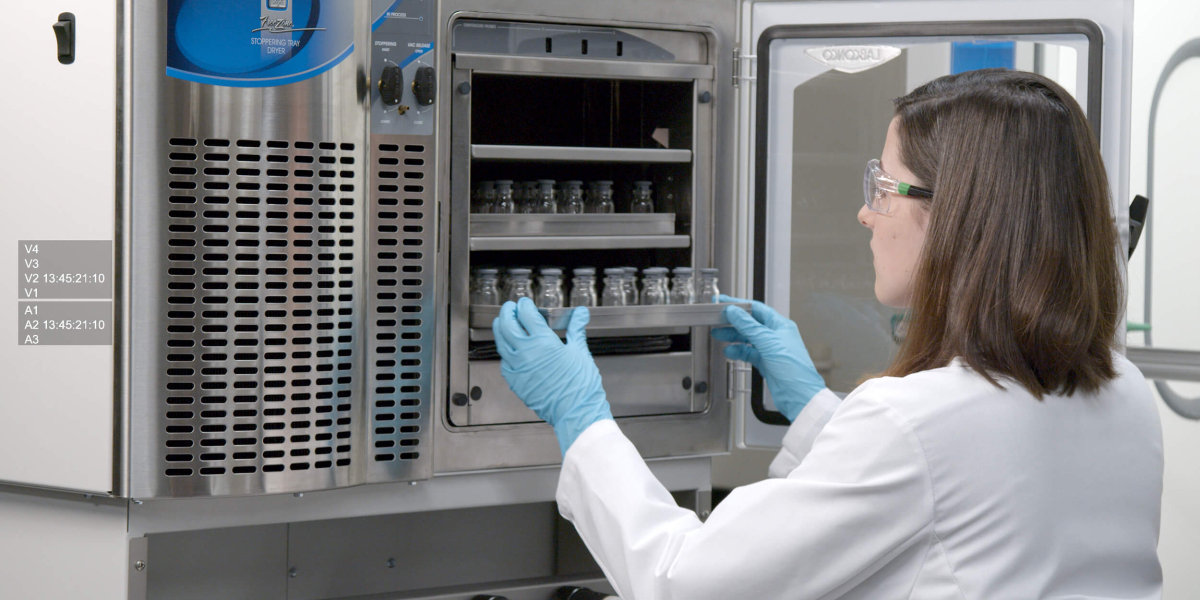Introduction to freeze drying

Freeze Drying, also known as lyophilization, is a process that is used for sample preparation. With its unique preservation properties, freeze drying has a large variety of applications with an ever-growing list of new uses each year.
What is freeze drying?
Freeze Drying is a process in which a completely frozen sample is placed under a vacuum in order to remove water or other solvents from the sample, allowing the ice to change directly from a solid to a vapor without passing through a liquid phase. This process, called sublimation, along with the minimal heat input that is required, is ideal because of the long-term preservation properties it provides to the integrity of the sample’s biological and chemical structure. Lyophilization can be achieved in various volumes, from small at-home freeze dryers all the way up to large, production-scale equipment.
What are freeze dryers used for?
The first major utilization of freeze drying was during World War II, for the transportation of blood, serum and penicillin. Since the development of these modern freeze-drying techniques, lyophilization technology has continued to advance and has been used for a broad spectrum of applications in a variety of fields. Laboratory freeze dryers are commonly used for research in biological and environmental disciplines, as well as in the research and development of many modern medicines.
In the home, lyophilizers are most commonly used to freeze dry foods. This form of preservation not only extends the shelf-life of foods, but has also been shown to lock in important nutrients and enhance flavor of things like fruits, vegetables, meats, and even coffee.
Equipment required for freeze drying
To successfully freeze dry a sample, your equipment will need to meet certain requirements. First, the collector coil of your freeze dryer will need to be 15-20 degrees colder than the freezing point of your sample in order to trap the water vapor that is being released. You will also need a vacuum pump that can reach a minimum of .020 mBar. This deep vacuum establishes negative pressure, forcing the free-flowing water molecules that have left the sample via sublimation to evacuate the environment around the sample and travel to the collector coil. You will also need to have a drying accessory, such as: a manifold, chamber or tray dryer, and glassware or trays to contain your sample. Although not required, an end-point detection system makes the (sometimes days-long) freeze-drying method easier to manage by keeping you informed of when your sample has finished drying.
Required Equipment
- Freeze dryer (vacuum tight chamber with collector coil)
- Vacuum pump that can reach an ultimate vacuum of .020 mBar or lower
- Vacuum-tight sample holders (flasks or vials with adapters, or chamber with trays)
Stages of Freeze Drying
There are three stages in the lyophilization process: Pre-freezing, primary drying, and secondary drying.
Pre-freezing
The pre-freezing stage is the most important stage of the freeze-drying process. In this stage, sample material will need to be cooled to at least the temperature of the melting point for that sample. This ensures the sample will be completely frozen and can then undergo sublimation. If the sample isn’t frozen solid, evaporation will occur and the sample will not achieve the same preservation properties that occur with sublimation.
The rate at which your sample freezes will affect the size of the ice crystals that form. If not done properly, it can impact the speed of reconstitution, length of the freeze-drying process and integrity and stability of your sample.
Larger ice crystals facilitate faster and more efficient lyophilization because water molecules are able to move more freely out of the sample during sublimation. For samples like food or tissues, large crystals can break the cell walls and damage your sample. In these situations, it is best for freezing to be done quickly through flash freezing, creating smaller ice crystals.
Primary Drying
Primary drying begins when you start your freeze dryer and vacuum pump. With the low pressure environment, evaporative cooling of the sample begins, allowing for energy in the form of heat to speed the freeze-drying process. At the end of primary drying, roughly 93% of the water in the sample is sublimated out. This stage can take several days, depending on the sample type and heat input. For laboratories that are using their freeze-drying equipment for sample preparation and resuspension, primary drying is where the run would end. For long term preservation of the sample, the run would continue on to secondary drying.
Secondary Drying
In the secondary drying phase, water molecules that are bound to the sample are released. Additional heat is added in this stage to drive off excess moisture, leaving behind a moisture content of about 2%. Secondary drying is typically used in samples that are being prepared for long term preservation and storage.
Why freeze dry?
While freeze drying can accomplish many things, its primary goal is to protect the biological and chemical structure of a sample through the process of sublimation. Once complete, the sample can be used for testing, long term preservation, or in the case of food, eaten. In the laboratory, the applications of freeze drying are limitless.
| chevron_left | Using methanol as an alternative to acetonitrile in lyophilization | Articles | Video: Patent issued for award winning Type C1 biosafety cabinet technology | chevron_right |






